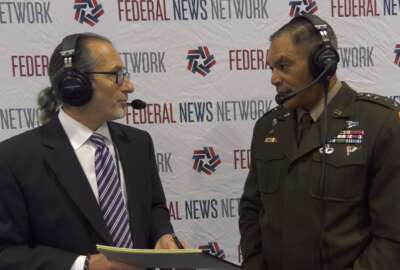
Army FORSCOM faces changes in troops’ needs, equipment and more
For an update on readiness, Federal Drive with Tom Temin caught up with FORSCOM Commander Gen. Michael Garrett at the Association of the U.S. Army conference i...
Best listening experience is on Chrome, Firefox or Safari. Subscribe to Federal Drive’s daily audio interviews on Apple Podcasts or PodcastOne.
The needs of Army combatant commanders are constantly changing. Troop training needs evolve as the U.S. population — the Army’s raw material — changes. Equipment and other support needs are also a moving target. It all comes home for the Army Forces Command (or FORSCOM). For an update on readiness, Federal Drive with Tom Temin caught up with FORSCOM Commander Gen. Michael Garrett at the Association of the U.S. Army conference in Washington, D.C., this week.
Interview transcript:
Tom Temin: General, I want to start in the very beginning. Everyone knows what CENTCOM is, all of the combatant commands. Tell us the brief story of FORSCOM.
Gen. Michael Garrett: FORSCOM provides decisive combat formations to all of the combatant commands. So if you think about CENTCOM and how we’ve supported them over the last 20 years, if you think about today, what we’re doing in INDOPACOM, AFRICOM, EUCOM, these are principally FORSCOM forces.
Tom Temin: So you’re the cross cutting force of the commands, you might say?
Gen. Michael Garrett: We represent a big chunk of the Army. If you think about a large portion of the active component, all of the Army Reserve. And we have a training and oversight responsibility for the Guard and the Guard falls under us when they are under Title 10.
Tom Temin: All right. And interesting we’re speaking, recently after the passing of General Odierno who tangled a lot with Congress and so forth on this whole issue of readiness. And that was an issue for the Army and a lot of the armed forces actually, over the past several years. Let’s talk about readiness and what it means in today’s Army. We’re not in Afghanistan anymore, and just spend some pullback here and there. Define readiness in the contemporary sense.
Gen. Michael Garrett: What I start with in most of my discussions anymore is to remind the folks that I’m talking to why we exist as an Army, and we only exist for one reason, to fight and to win our nation’s wars. The readiness that we generate has to be sufficient to do that. We also have, I mean, we’re at a very interesting point in time. Modernization, people, readiness, these are the Army’s priorities. And if we don’t manage them carefully, we’re either not going to have sufficient readiness to meet combatant commanders requirements, or we’re going to fall off of some of our very important modernization efforts. Or we’re not going to take care of the people that we have in the Army in the way that they deserve to be taken care of.
Tom Temin: You said modernization, and that does get mixed up with the idea of readiness quite a bit, because readiness when you think about it, there’s the people component, but they can’t go in with just a fire hose in their hand to a combat, so the equipment, and then the whole support tail that goes back to the it in the cloud and all of this. Tell us about monetization from your standpoint.
Gen. Michael Garrett: Yeah, so FORSCOM is all about readiness. Modernization is future readiness, and its readiness that we absolutely have to have. And its readiness, and we talk a lot about our modernization efforts, and we are modernizing not just equipment. But we’re also modernizing the way we manage people, the way we manage talent in the Army. We are modernizing the way that we manage and look at readiness in the Army. I’ve tried to, and I’m sure I’m not the first FORSCOM commander to do this, but on any given day my goal is to provide the exact amount of readiness that we need to meet combatant commander requirements and not a whole bunch more, because a whole bunch more is wasteful if you look at its potential impact on our modernization and our people efforts.
Tom Temin: And does the soldier training doctrine, does that come out of FORSCOM?
Gen. Michael Garrett: The doctrine actually comes out of TRADOC. So General Funk and Training and Doctrine Command are responsible for the doctrine. And then once the doctrine is developed, it’s given to the Army and then we take it from there.
Tom Temin: All right. And so how has that changed? Let’s talk about that issue of training. How has that changed to accommodate what it is you are getting as people that enlist in the first place, the raw material? And there’s several tens of thousands every year that are coming in, in this in this process. How has that changed?
Gen. Michael Garrett: The chief often says, and he’s exactly right, we are in a war for talent. If you look at our country today, only 29% of young men and women meet the requirements to be eligible to serve in the Army. And so we are competing and fighting for that talent every single day. The other piece is as we look at readiness and what’s really important about our Army is that we have soldiers, and it all starts, these are foundational thing, soldiers who are disciplined, soldiers who are fit, soldiers who are well trained, and soldiers who are part of a cohesive team squad. That is the foundation of our Army. I was in Europe last week talking to some of our formations over there. And I remind them real readiness is a tank crew that can acquire a target, engage the target, and move on to the next target faster than our enemy. That’s where it all, that’s where it all starts.
Tom Temin: And if you look outside the Army, there has been a push over the past number of years to incorporate some of society’s let’s say, political, social, changing trends, and express them in the component makeup, human wise of the military. And we’ll just leave it at that, enough to describe it. But yet at some point, you have to accommodate that and almost celebrate it. But at the same time, you need people that think in a certain way, as you say, once they’re in the tank, when all of that really shouldn’t even be a factor. So how do you balance all of that?
Gen. Michael Garrett: The good thing about our Army is we have a set of values that we all live by, we bring in young men and women from all parts of the world really, not just the United States. And they represent the diversity that makes our Army the Army that it is today, we certainly value that. But our values are what I think separates our Army from other portions of society. And there are a number of changes ongoing socially, and the Army is not immune to any of those. I mean, we are reflective of society, and we do our absolute best to deal with them. Taking care of our people is our number one priority. And I personally think the best way we take care of people in the Army is to make sure that they are trained to do their job, that they are challenged every day, and that we provide for soldiers and families so that they do want to stay with us.
Tom Temin: And let’s talk about the people then beyond the induction and training and so forth, and at some point, they have to be identified as officer material. How has that evolved, again, against this backdrop of change in doctrine and change in the strategy of the United States, which is moving toward great powers, the changes in society? It’s a lot to bring in to someone that says, that’s an officer.
Gen. Michael Garrett: I think the way we develop our officers has not changed that much over the years. I mean, yesterday, it was a huge honor. I was inducted into the ROTC Hall of Fame with a whole bunch of other really great friends, couple bosses. And I was struck by the fact that, West Point, ROTC, OCS, those commissioning sources, really haven’t changed a whole bunch. But what we have done is, and again, this is a trade off responsibility, but what we have done is we work very, very hard to fight for the talent that I described to you earlier, especially for our officer corps. So I am very, very pleased with the young men and women who raised the right hand, after they graduate from college, or go to, the United States Military Academy, or even those who are commissioned through OCS that make a huge difference.
Tom Temin: We’re speaking with General Michael Garrett, commander of US Army Forces Command, FORSCOM. Earlier you said that you serve the combatant commands with what it is they need to do their mission, what’s the feedback loop mechanisms such that you know what their changing needs are or may not change radically. But there’s a lot of subtle things that may change from generation to generation, week to week, month to month, depending on how the world is. How do you know what they need?
Gen. Michael Garrett: Yeah, first of all, we have very, very close relationships with the combatant commanders themselves.
Tom Temin: You all came up together.
Gen. Michael Garrett: Absolutely. The Chief of Staff of the Army meets with them routinely. But really where we gain the perspective that we need and have on any given day is from our Army component commanders. So think about INDOPAYCOM , the four star headquarters that we have, the Army component there is United States Army Pacific, and General Flynn, who is the commander there he is the INDOPAYCOM’s commanders Army commander, and the conversations between the two of them really determine what the Army requirements are, and also the feedback that you alluded to, in terms of how we’re doing, that’s where it comes from. So I would tell you that our Army service component commanders provide the interface directly and the day to day interaction with the combatant commands.
Tom Temin: And this change in national policies, so called the potential great powers conflict, that’s kind of a rolling change in policy and affecting again, all branches of DoD. How has that affected FORSCOM and how do you think differently than perhaps he did before that change?
Gen. Michael Garrett: I don’t think any differently. I mean, it doesn’t change our responsibility to provide manned, trained and equipped forces to combatant commanders. That doesn’t change, and that’s my primary mission and focus on any given day. We are looking at the future of warfare, we’re looking at new formations or multi domain operations, task forces, or security force assistance brigades, are just a couple of examples of some of the new units that we’re going to introduce to meet the requirements that we foresee in the future.
Tom Temin: And there’s been some work in cold environments too also.
Gen. Michael Garrett: I commanded United States Army Alaska, and I served in the Army’s airborne brigade in Alaska. The chief, this last year published the Arctic strategy. And we are looking very, very hard at not just being able to operate in the Arctic, but to win in the Arctic.
Tom Temin: So what’s tougher, heat or cold?
Gen. Michael Garrett: They are both conditions, right. So in the Army, and as a trainer, the task never changes, the standards to perform that task never change. But what changes constantly are the conditions. So the conditions of being in the desert or being in the frozen tundra, all boiled down to, and I think this is the most impactful aspect of anything that we do, and it’s leadership, right, So leadership, is what gets you through operating in the desert, and it certainly will get you through operating in the Arctic.
Tom Temin: Would you say you’re optimistic about the future of the Army given what you see in the raw material in society and everything else?
Gen. Michael Garrett: Oh, absolutely. I mean, I got a son in the Army. I have a son in law in the Army. Most of my friends have kids in the Army. And I know that my son and son in law are better men than I am. I have no problems when I consider the future of our Army.
Tom Temin: And you’re not the first in your family, either.
Gen. Michael Garrett: No, I’m not, no, I’m not. And it’d be interesting if you asked my dad this question like 30 years ago. But I tell you, I know my kids are better, and these young kids, young men and women, they’re not kids, they’re young men and women that join our Army are just incredible. And no, I have no concern. The only concern I have sometimes is that old people like me, don’t get too much in the way.
Tom Temin: And final question. How’s that new SIG rolling out as it spreads throughout the Army to replace the Berettas?
Gen. Michael Garrett: Oh, good. No, that’s good pistol, it’s good pistol.
Copyright © 2024 Federal News Network. All rights reserved. This website is not intended for users located within the European Economic Area.
Tom Temin is host of the Federal Drive and has been providing insight on federal technology and management issues for more than 30 years.
Follow @tteminWFED





